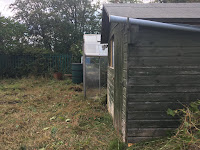All gardeners, allomenteers, grow your own specialists and humble window box growers know that weeds are the bane of our existence. They are a right pain to get on top of any sometimes when you think you have got them all they come back with avenges and they take over what every you are trying to achieve. Some of the weeds are quite easy to keep on top of but some are like your worst enemy as if you leave as little as the nail on your little finger they will come back and take over again.
Us personally on the allotment is currently struggling with Equisetum arvense which is better know by the names of mare's tail & horse's tail. It is an invasive deep rooted, perennial weed which will quickly and effectively take over your garden or allotment. I have not heard of many cases in which it has penetrated window boxers or hanging baskets but there must be a possibility of it being able to happen as it gets in everywhere else. When we first got the allotment back in August last year (2018) it was swarmed with high weeds, very high weeds which at first I didn't know was Equisetum arvense. As you will see from the images below I cut it all back and cleared the plot what at the time seemed like the best thing to do at the time as we wanted to know how big of an area we had to play with.


As you can see it opened up the whole allotment so we could see what area we had and started making plans on where we wanted to relocate the shed and greenhouse, but this was a mistake. As it was only August and the weather was nice unlike this years. We should have just treated it straight away with a strong weed killer that is designed to clear Equisetum arvense. I know spraying a whole allotment with weed killer is not advisable in peoples eyes as it means you cant claim that its organically grown fruit and veg, but I have checked online and spoken to many people about getting rid of the weed without using weed killers and it is a very very long process that I am not looking to do as the most productive one I found was to cover the allotment for 3 years with black plastic then lay soil and turf down. On top of that have 3 goats grassing for the 3 years and there is no way I could wait that long or get my hands on 3 goats so its down the weed killer route for me.
I spent hours and hours online looking at which weed killers are deigned to take it out, I read deeply into all the reviews online and what ways to to treat. I came across a few brands which where deigned for Equisetum arvense but the one that stood out to me the most was Kurtail Gold from pro-green. I decided this was the one to go for so I went onto the website and went to order myself some but it wouldn't let me, just before I was able to order the legislation had changed on about what chemicals can be used in weed killers and Kurtail Gold had one of them said chemicals in and wasn't allowed to be sold anymore. It was a real blow to the system as it shouldn't perfect, you didn't have to break or bruise the plants before spraying which made life a lot easier and I had my head and heart set on getting that one to sort the allotment out of its Equisetum arvense infestation. Luckily enough Pro-Green was working on a replacement and it would be hopefully coming out soon.
We had already cut all the Equisetum arvense back and cleared it off our allotment, so I begin to move the shed and greenhouse around. Over the space of a few months I built a new base for the shed, moved it across to its new location and also built a patio area out the front of it so Dawn can come up and have somewhere flat and level to stand on or even sit on in the camping chairs. After the moving off the shed I started to build the new base for the greenhouse, I dug down and built the base into the ground as I want to use the soil inside of the greenhouse instead of grow bags as I can constantly keep improving the soil year after year. During this process none of the Equisetum arvense was starting to grow back inside where I decided to move the greenhouse too even tho it was breaking through in after parts of the allotment. Once the greenhouse was fixed into its new position I was over the moon as no Equisetum arvense had started to grow at all where it was located too but unfortunately the next week it began to grow and it is now starting to take over the greenhouse as you can see from the picture at the top of this blog.
I got home that evening and went straight onto the Pro-Green website and yes they had improved the Kurtail Gold with all chemicals that are allowed to be used and it was renamed to Kurtail Evo. I purchased a bottle as soon as I could and waited on it to arrive. It came in good time and was with me within two to three days, I took it straight up the allotment ready for when I would be up there next.
That weekend I headed straight up the allotment to spray the whole plot to hopefully start killing off the Equisetum arvense, the weather forecast for the day was sun until later that evening so I was going to get a few hours of the weed killer on the plants before it rained. I mixed the recommended amount of Kurtail Evo to 5 litres of water and began spraying. I made sure I got in all the little nooks and crannies so all the plot was treated, spraying the whole allotment actually went a lot quicker then I thought it would have taken. I had never used a Spear & Jackson 5 litre sprayer before and the pressure it kept up inside the bottle was amazing. I only had to re-pump the spray twice to use the whole 5 litres of the mixture inside the sprayer. After spraying the whole plot and tidying down I took this picture below to show the before image.
I then begin to walk back home, along the way I took photos of all the scarecrows the other plot owners have done for anyone to see while walking along the path next to the allotments. After about 10 minutes it started to drizzle which I was hoping would stop right away but how wrong was I, the heaven then opened and didn’t stop for at least 7 hours. The amount of rain that fell in the 7 hours of downpour was probably enough to wash my whole allotment away, so all the weed killer would have been completely washed away. Which is a complete shame as that wasted a third of my Kurtail Evo. The next day I returned to the allotment to see if any of it took at all and I couldn’t see any change to anything on the allotment which was a bit optimistic as no weed killer would kill anything in 24 hours with the amount of rainfall we had. I then risked it again and sprayed the whole plot again and took a picture of the Equisetum arvense which is breaking through the greenhouse base. Luckily that evening there was no rain until early hours of the morning which meant the Kurtail Evo was on the plants for at least a minimum of 6 hours and the required minimum amount of time is 3 hours before rainfall. My hoping and praying must have worked as I didn’t want to be wasting another third of the Kurtail Evo.
As you can see in the images the second spray worked well, it has killed off most the Equisetum arvense but I personally think next time I need to set the sprayer to a mist instead of a stream like I was using. All of the Equisetum arvense in the greenhouse is now dead and is looking amazing as you can see from the picture below.
Since I took these pictures there has been some slight regrowth in the greenhouse and around the allotment also but I will spray it again in the next couple of weeks.
So to conclude, Kurtail Evo is a great product to tackle Equisetum arvense when it is applied right and it doesn’t rain. There is no bruising or breaking of the plant before unlike most other weed killers advertised to kill Equisetum arvense (mares tail / horses tail). There is always the possibility of regrowth due to the nature of the plant but it is easily treated again with Kurtail Evo when it has reached the recommend height.
I hope this blog post hasn’t been to long or boring of a post for people to read, also hopefully it will help anyone else who is looking to take on the battle with Equisetum arvense. Also if you would like to see the process in action go check out my YouTube Channel.
Michael






























